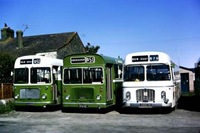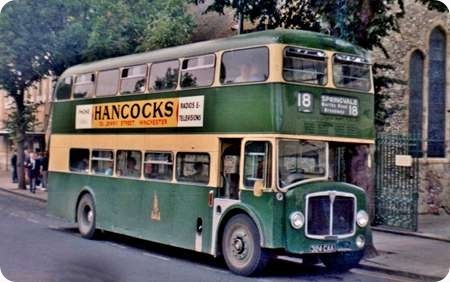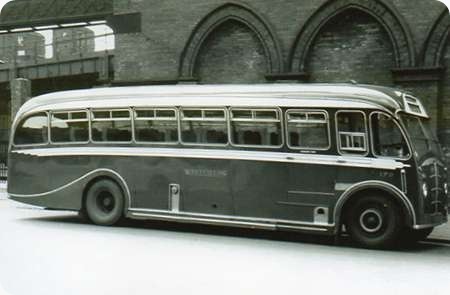Crosville – Bristol RE – HFM 595D – ERG 595
Crosville Motor Services
1966
Bristol RELL6G
ECW DP50F
Crosville had a very large operating area, and Aberaeron Depot was almost 100 miles from the Company’s headquarters at Chester Here we see three of the Company’s earlier RE’s lined up in the Depot yard.
ERG 595 registration HFM 595D was one of Crosville’s only three examples of the RELL6G in it’s earliest version, with manual gearbox and the first style of ECW bodywork. These three vehicles were the first dual-purpose RELL’s, previous dual purpose RE’s for other operators having been based on the RELH chassis. These three vehicles were new in the short lived dual-purpose livery of cream with a single green band. Although fitted for OMO from new, they were initially used with conductors on the Chester – Caernarfon "Cymru Coastliner" service. Eventually ERG 593 and 595 were eventually transferred to Aberaeron depot, where they were used on the lengthy services southwards from Aberystwyth. At the end of their lives they were fitted with bus seats to increase their capacity on school workings.
SRG 10 registration OFM 10E was a standard RELL6G bus, one of the earliest examples with semi-automatic gearboxes and the second body style. Although the long bus version was the most common variant of the RE model, only about a third of Crosville’s 317 RE’s were of this type.
CRG 496 registration 5458 FM was a 1963 RELH6G coach, one of Crosville’s first quartet of RE’s. Having been used on the Liverpool – London express services, it was now living a quieter life in rural Mid-Wales.
Photograph and Copy contributed by Don McKeown
26/09/13 – 06:42
RE; my favourite rear engined bus; RELH; second only to the ZF Reliance in my coaching affections. Ironic that I’ve only just posted (with the King Alfred Bridgemaster) about the abortive attempts to put AH691s into REs. A very nice shot of a classic trio.
David Oldfield
26/09/13 – 18:04
I totally agree with you David. One man operating was more of a pleasure when driving an RE, and for me the longer the journey the better. I’d rather drive a country service any day than monotonous town services around Cambridge. We had two of the manual gearbox RE’s which were referred to by everyone as RS’s. They had a top speed of about 80+ which I discovered one day on the 428 service to Bedford. I hadn’t any passengers on at one stage of the journey, and kept my foot down on a long straight section to satisfy my curiosity. The later RE’s with semi-auto gear selection were my absolute favourites especially the coaches…. luxury for both passenger and driver.
Norman Long
27/09/13 – 07:01
Yes, Norman. I had a RELL6L on the M4 once which just flew. (I had to reign back because the unladen front was coming off the road surface.) …..and I fully agree about the RELH – true luxury for driver and passenger.
David Oldfield
27/09/13 – 10:56
One of the best coach journeys I ever made was aboard an ECW coach bodied RE. The seats were very comfortable the leg room adequate and the coach gave a wonderfully smooth ride. The coach was far from new but would still knock modern stuff into a cocked hat.
Chris Hough
28/09/13 – 07:21
For a while I lived in Chipping Sodbury and worked in Bristol, and my evening journey home was usually on a semi-automatic RELH6L coach cascaded to bus duties, which made for an extremely relaxing end to the working day. The only problem was that because 234&5 on the gear selector were in the same positions as 123&4 on the more familiar four-speed version, the drivers changed gear at the same speeds. So the engine never really got into its stride before changing up – most frustrating, and a good thing there were no serious hills on the journey!
Peter Williamson
29/09/13 – 10:45
A delightful trio. I concur with the praise of the RE coach. I was smitten from a young age by long Royal Blue journeys from Victoria Coach Station to Bridport and Perranporth. And those preserved today are still robust, strong and comfortable, with none of the rattles and harshness of modern coaches.
I believe that the manual gearbox version had the edge on top speed, although the semi auto might have been an easier driver’s coach.
Petras409
30/09/13 – 15:41
In the early 1970’s, I and my young family were fairly frequent users of the overnight Scottish coach service from Edinburgh to London Victoria (then travelling on by coach to family in Clacton or Portsmouth). The coaches were the stylish Alexander M-type, supplied on a variety of chassis. At one point, SBG distributed a survey to all the passengers, and I remember completing one part of the comments section with my opinion of the ride the different makes offered! Who knows what the recipients thought of that. I don’t recall what comments I made about AEC (sorry, guys) or Seddon (not sure whether these had been introduced at the time). But I do know that I stated I found the Leyland Leopards hard or harsh on springing, and the Bristol REs a nice soft ride for a night-time sleep. (But, regrettably – and a pointer to the future – , I found that Volvos were the most comfortable on this journey). So I can largely concur with the comments here on the Bristol RE in it’s other forms as coach and bus – even though I am not a driver. (And, yes, some drivers on the SBG service really did make a change en-route on the motorway, with the vehicle in motion – I’m sure I wasn’t dreaming it!)
Michael Hampton
30/09/13 – 17:42
Well it was a party trick that H & S wouldn’t countenance now but lots of things happened when we were lads! As for Volvos, they were a later generation and cannot fairly or safely be compared.
David Oldfield
30/09/13 – 17:43
They were some long journeys, Michael, in time and distance. Your mention of moving driver-changing reminds me of one experience of this.
Around 1970, my wife and I, impoverished, decided to have a cheap holiday and booked a Cosmos 10-day one to Lido de Jesolo for £29 each! I think it was rail to Dover, then a Belgian Railways passenger ferry to Ostende. A driver with an Alfa Romeo coach met us and off we went. After about an hour, we stopped by the side of the motorway and picked up another driver who took over and the original driver went to the back of the coach to sleep. The driver could not seem to get the hang of the eight-speed gearbox and there was a smell of burning. The original driver took over the wheel (without stopping) and carried on until we had a late-meal stop at Aachen. We were halfway back in the coach and, throughout the night, kept hearing loud talk and loud bursts of laughter from the front. When we stopped around 5am for a ‘comfort break’ it transpired that the relief driver had disappeared at Aachen and the original driver had continued at the wheel, inevitably starting to fall asleep at the wheel periodically! Being British, those nearest the driver did not ask him to pull over and take a rest, rather they kept a close vigil and started the false loud chatter/laughter to wake him up whenever he drooped! We were glad to be well away from the drama at the front! Suffice to say we arrived safely and many more hilarious things, not bus-related, occurred during the holiday!
Chris Hebbron
01/10/13 – 06:30
About six years ago, I was involved in driving a summer time shuttle from Uxbridge to Les Deux Alps (in the south of France) taking students snow-boarding. To comply with hours, and also keep a tight schedule, we had four drivers – but we always stopped at proper halts by the road side. I had an interesting drive down the side of the mountain on a typical zig-zag road. Now changing on the move there would have been VERY interesting…..
David Oldfield
02/10/13 – 07:13
I never had the pleasure of driving an RELH6G, but I knew a couple of United’s drivers on the Newcastle/London route, and they spoke very highly of them. United always specified a lower seating capacity for the vehicles on this route, and the extra legroom made them very popular with passengers. They were worked hard, but well looked after. A six hundred mile round trip to London was nothing unusual for them, one crew took them down, then stay overnight or through the day, the vehicles went to London Transports Victoria depot, where they were cleaned out, refuelled and checked over before returning north with a different crew who had come south the previous night or day, then the same routine at the Newcastle end. On occasion, they were used on the Lowestoft or Glasgow runs, or on private hires and excursions. Some of them must have clocked up a phenomenal mileage during their lives.
Ronnie Hoye
 Vehicle reminder shot for this posting
Vehicle reminder shot for this posting
02/12/13 – 11:22
Just came across this site whilst looking for a picture to show my kids of the type of buses I went to school on.
Amazed to find the actual buses! From 1975 to 1980 I went from NewQuay to school in Aberaearon, initially on older rounded front buses, possibly Bristol LS’, then from about 77 on these beauties. They were still in use when I finished school but were joined by a Leyland National, which for some reason we called ‘The Prison Bus’ can’t remember why, it may have had something to do with the plastic seats and lots of bars/grab rails. I think the white one on the right had big coach like opening roof vents that you could fit a school bag out of, don’t ask me how I know!
Richard Snelus
Quick links to the - Comments Page - Contact Page - Home Page



